5.4E: Exercises for Section 5.4
- Page ID
- 160534
\( \newcommand{\vecs}[1]{\overset { \scriptstyle \rightharpoonup} {\mathbf{#1}} } \)
\( \newcommand{\vecd}[1]{\overset{-\!-\!\rightharpoonup}{\vphantom{a}\smash {#1}}} \)
\( \newcommand{\dsum}{\displaystyle\sum\limits} \)
\( \newcommand{\dint}{\displaystyle\int\limits} \)
\( \newcommand{\dlim}{\displaystyle\lim\limits} \)
\( \newcommand{\id}{\mathrm{id}}\) \( \newcommand{\Span}{\mathrm{span}}\)
( \newcommand{\kernel}{\mathrm{null}\,}\) \( \newcommand{\range}{\mathrm{range}\,}\)
\( \newcommand{\RealPart}{\mathrm{Re}}\) \( \newcommand{\ImaginaryPart}{\mathrm{Im}}\)
\( \newcommand{\Argument}{\mathrm{Arg}}\) \( \newcommand{\norm}[1]{\| #1 \|}\)
\( \newcommand{\inner}[2]{\langle #1, #2 \rangle}\)
\( \newcommand{\Span}{\mathrm{span}}\)
\( \newcommand{\id}{\mathrm{id}}\)
\( \newcommand{\Span}{\mathrm{span}}\)
\( \newcommand{\kernel}{\mathrm{null}\,}\)
\( \newcommand{\range}{\mathrm{range}\,}\)
\( \newcommand{\RealPart}{\mathrm{Re}}\)
\( \newcommand{\ImaginaryPart}{\mathrm{Im}}\)
\( \newcommand{\Argument}{\mathrm{Arg}}\)
\( \newcommand{\norm}[1]{\| #1 \|}\)
\( \newcommand{\inner}[2]{\langle #1, #2 \rangle}\)
\( \newcommand{\Span}{\mathrm{span}}\) \( \newcommand{\AA}{\unicode[.8,0]{x212B}}\)
\( \newcommand{\vectorA}[1]{\vec{#1}} % arrow\)
\( \newcommand{\vectorAt}[1]{\vec{\text{#1}}} % arrow\)
\( \newcommand{\vectorB}[1]{\overset { \scriptstyle \rightharpoonup} {\mathbf{#1}} } \)
\( \newcommand{\vectorC}[1]{\textbf{#1}} \)
\( \newcommand{\vectorD}[1]{\overrightarrow{#1}} \)
\( \newcommand{\vectorDt}[1]{\overrightarrow{\text{#1}}} \)
\( \newcommand{\vectE}[1]{\overset{-\!-\!\rightharpoonup}{\vphantom{a}\smash{\mathbf {#1}}}} \)
\( \newcommand{\vecs}[1]{\overset { \scriptstyle \rightharpoonup} {\mathbf{#1}} } \)
\( \newcommand{\vecd}[1]{\overset{-\!-\!\rightharpoonup}{\vphantom{a}\smash {#1}}} \)
\(\newcommand{\avec}{\mathbf a}\) \(\newcommand{\bvec}{\mathbf b}\) \(\newcommand{\cvec}{\mathbf c}\) \(\newcommand{\dvec}{\mathbf d}\) \(\newcommand{\dtil}{\widetilde{\mathbf d}}\) \(\newcommand{\evec}{\mathbf e}\) \(\newcommand{\fvec}{\mathbf f}\) \(\newcommand{\nvec}{\mathbf n}\) \(\newcommand{\pvec}{\mathbf p}\) \(\newcommand{\qvec}{\mathbf q}\) \(\newcommand{\svec}{\mathbf s}\) \(\newcommand{\tvec}{\mathbf t}\) \(\newcommand{\uvec}{\mathbf u}\) \(\newcommand{\vvec}{\mathbf v}\) \(\newcommand{\wvec}{\mathbf w}\) \(\newcommand{\xvec}{\mathbf x}\) \(\newcommand{\yvec}{\mathbf y}\) \(\newcommand{\zvec}{\mathbf z}\) \(\newcommand{\rvec}{\mathbf r}\) \(\newcommand{\mvec}{\mathbf m}\) \(\newcommand{\zerovec}{\mathbf 0}\) \(\newcommand{\onevec}{\mathbf 1}\) \(\newcommand{\real}{\mathbb R}\) \(\newcommand{\twovec}[2]{\left[\begin{array}{r}#1 \\ #2 \end{array}\right]}\) \(\newcommand{\ctwovec}[2]{\left[\begin{array}{c}#1 \\ #2 \end{array}\right]}\) \(\newcommand{\threevec}[3]{\left[\begin{array}{r}#1 \\ #2 \\ #3 \end{array}\right]}\) \(\newcommand{\cthreevec}[3]{\left[\begin{array}{c}#1 \\ #2 \\ #3 \end{array}\right]}\) \(\newcommand{\fourvec}[4]{\left[\begin{array}{r}#1 \\ #2 \\ #3 \\ #4 \end{array}\right]}\) \(\newcommand{\cfourvec}[4]{\left[\begin{array}{c}#1 \\ #2 \\ #3 \\ #4 \end{array}\right]}\) \(\newcommand{\fivevec}[5]{\left[\begin{array}{r}#1 \\ #2 \\ #3 \\ #4 \\ #5 \\ \end{array}\right]}\) \(\newcommand{\cfivevec}[5]{\left[\begin{array}{c}#1 \\ #2 \\ #3 \\ #4 \\ #5 \\ \end{array}\right]}\) \(\newcommand{\mattwo}[4]{\left[\begin{array}{rr}#1 \amp #2 \\ #3 \amp #4 \\ \end{array}\right]}\) \(\newcommand{\laspan}[1]{\text{Span}\{#1\}}\) \(\newcommand{\bcal}{\cal B}\) \(\newcommand{\ccal}{\cal C}\) \(\newcommand{\scal}{\cal S}\) \(\newcommand{\wcal}{\cal W}\) \(\newcommand{\ecal}{\cal E}\) \(\newcommand{\coords}[2]{\left\{#1\right\}_{#2}}\) \(\newcommand{\gray}[1]{\color{gray}{#1}}\) \(\newcommand{\lgray}[1]{\color{lightgray}{#1}}\) \(\newcommand{\rank}{\operatorname{rank}}\) \(\newcommand{\row}{\text{Row}}\) \(\newcommand{\col}{\text{Col}}\) \(\renewcommand{\row}{\text{Row}}\) \(\newcommand{\nul}{\text{Nul}}\) \(\newcommand{\var}{\text{Var}}\) \(\newcommand{\corr}{\text{corr}}\) \(\newcommand{\len}[1]{\left|#1\right|}\) \(\newcommand{\bbar}{\overline{\bvec}}\) \(\newcommand{\bhat}{\widehat{\bvec}}\) \(\newcommand{\bperp}{\bvec^\perp}\) \(\newcommand{\xhat}{\widehat{\xvec}}\) \(\newcommand{\vhat}{\widehat{\vvec}}\) \(\newcommand{\uhat}{\widehat{\uvec}}\) \(\newcommand{\what}{\widehat{\wvec}}\) \(\newcommand{\Sighat}{\widehat{\Sigma}}\) \(\newcommand{\lt}{<}\) \(\newcommand{\gt}{>}\) \(\newcommand{\amp}{&}\) \(\definecolor{fillinmathshade}{gray}{0.9}\)Exercise 1
- Given \(\mathbf r(t)=(3t^2−2)\,\mathbf{i}+(2t−\sin t)\,\mathbf{j}\):
- Find the velocity of a particle moving along this curve.
- Find the acceleration of a particle moving along this curve.
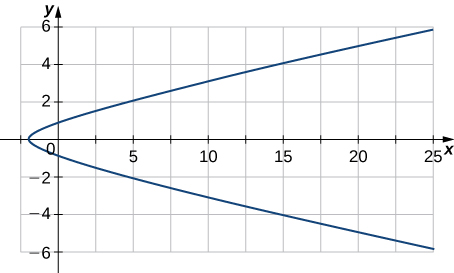
- Answer
-
- \(\mathbf v(t)=6t\,\mathbf{i}+(2−\cos t)\,\mathbf{i}\)
- \(\mathbf a(t)=6\,\mathbf{i}+\sin t\,\mathbf{i}\)
Exercises 2 - 5
Given the position function, find the velocity, acceleration, and speed in terms of the parameter \(t\).
- \(\mathbf r(t)=e^{−t}\,\mathbf{i}+t^2\,\mathbf{j}+\tan t\,\mathbf{k}\)
- \(\mathbf r(t)=⟨3\cos t,\,3\sin t,\,t^2⟩\)
- Answer
- \(\mathbf v(t)=-3\sin t\,\mathbf{i}+3\cos t\,\mathbf{j}+2t\,\mathbf{k}\)
\(\mathbf a(t)=-3\cos t\,\mathbf{i}-3\sin t\,\mathbf{j}+2\,\mathbf{k}\)
\(\text{Speed}(t) = \|\mathbf v(t)\| = \sqrt{9 + 4t^2}\)
- \(\mathbf r(t)=t^5\,\mathbf{i}+(3t^2+2t- 5)\,\mathbf{j}+(3t-1)\,\mathbf{k}\)
- \(\mathbf r(t)=2\cos t\,\mathbf{j}+3\sin t\,\mathbf{k}\). The graph is shown here:
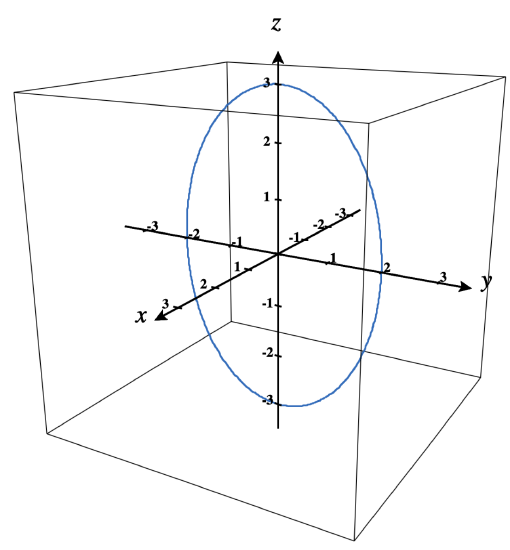
- Answer
- \(\mathbf v(t)=-2\sin t\,\mathbf{j}+3\cos t\,\mathbf{k}\)
\(\mathbf a(t)=-2\cos t\,\mathbf{j}-3\sin t\,\mathbf{k}\)
\(\text{Speed}(t) = \|\mathbf v(t)\| = \sqrt{4\sin^2 t+9\cos^2 t}=\sqrt{4+5\cos^2 t}\)
Exercises 6 - 8
Find the velocity, acceleration, and speed of a particle with the given position function.
- \(\mathbf r(t)=⟨t^2−1,t⟩\)
- \(\mathbf r(t)=⟨e^t,e^{−t}⟩\)
- Answer
- \(\mathbf v(t)=⟨e^t,−e^{−t}⟩\),
\(\mathbf a(t)=⟨e^t, e^{−t}⟩,\)
\( \|\mathbf v(t)\| = \sqrt{e^{2t}+e^{−2t}}\)
- \(\mathbf r(t)=⟨\sin t,t,\cos t⟩\). The graph is shown here:
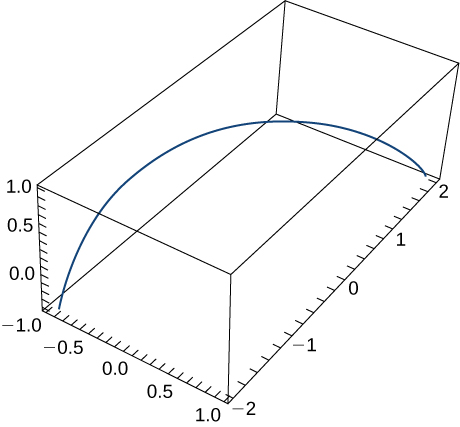
- The position function of an object is given by \(\mathbf r(t)=⟨t^2,5t,t^2−16t⟩\). At what time is the speed a minimum?
- Answer
- \(t = 4\)
- Let \(\mathbf r(t)=r\cosh(ωt)\,\mathbf{i}+r\sinh(ωt)\,\mathbf{j}\). Find the velocity and acceleration vectors and show that the acceleration is proportional to \(\mathbf r(t)\).
- Consider the motion of a point on the circumference of a rolling circle. As the circle rolls, it generates the cycloid \(\mathbf r(t)=(ωt−\sin(ωt))\,\mathbf{i}+(1−\cos(ωt))\,\mathbf{j}\), where \(\omega\) is the angular velocity of the circle and \(b\) is the radius of the circle:
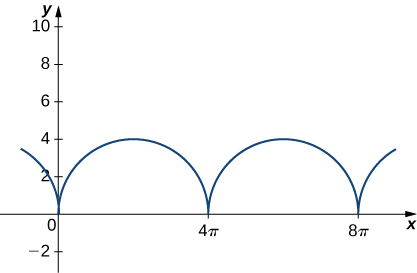
Find the equations for the velocity, acceleration, and speed of the particle at any time.
- Answer
- \(\mathbf v(t)=(ω−ω\cos(ωt))\,\mathbf{i}+(ω\sin(ωt))\,\mathbf{j}\)
\(\mathbf a(t)=(ω^2\sin(ωt))\,\mathbf{i}+(ω^2\cos(ωt))\,\mathbf{j}\)
\(\begin{align*} \text{speed}(t) &= \sqrt{(ω−ω\cos(ωt))^2 + (ω\sin(ωt))^2} \\
&= \sqrt{ω^2 - 2ω^2 \cos(ωt) + ω^2\cos^2(ωt) + ω^2\sin^2(ωt)} \\
&= \sqrt{2ω^2(1 - \cos(ωt))} \end{align*} \)
- A person on a hang glider is spiraling upward as a result of the rapidly rising air on a path having position vector \(\mathbf r(t)=(3\cos t)\,\mathbf{i}+(3\sin t)\,\mathbf{j}+t^2\,\mathbf{k}\). The path is similar to that of a helix, although it is not a helix. The graph is shown here:
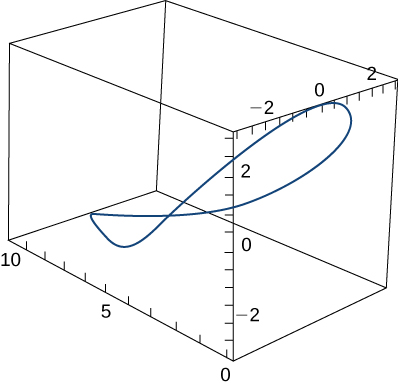
Figure \(\PageIndex{5}\): The graph of the given vector function is a curve that forms a smooth arc. The plot is enclosed within a rectangular box with the horizontal axis ranging from 10 to 0, the vertical axis ranging from -3 to 3, and the depth axis ranging from -3 to 3. The curve is a closed loop. The curve begins near the bottom-left corner of the graph, rises as it moves to the right, turns around, and then descends back to the starting point, forming a shape the like boundary of a "potato chip".
Find the following quantities:
- The velocity and acceleration vectors
- The glider’s speed at any time
- The times, if any, at which the glider’s acceleration is orthogonal to its velocity
- Answer
-
- \(\|\mathbf v(t)\|=\sqrt{9+4t^2}\)
- Given that \(\mathbf r(t)=⟨e^{−5t}\sin t,\, e^{−5t}\cos t,\, 4e^{−5t}⟩\) is the position vector of a moving particle, find the following quantities:
- The velocity of the particle
- The speed of the particle
- The acceleration of the particle
- Answer
-
- \(\mathbf v(t)=⟨e^{−5t}(\cos t−5\sin t),\, −e^{−5t}(\sin t+5\cos t),\, −20e^{−5t}⟩\)
- \(\mathbf a(t)=⟨e^{−5t}(−\sin t−5\cos t)−5e^{−5t}(\cos t−5\sin t), \; −e^{−5t}(\cos t−5\sin t)+5e^{−5t}(\sin t+5\cos t),\; 100e^{−5t}⟩\)
- Find the maximum speed of a point on the circumference of an automobile tire of radius \(1\) ft when the automobile is traveling at \(55\) mph.
- Find the position vector-valued function \(\mathbf r(t)\), given that \(\mathbf a(t)=\mathbf{i}+e^t \,\mathbf{j}, \quad \mathbf v(0)=2\,\mathbf{j}\), and \(\mathbf r(0)=2\,\mathbf{i}\).
- Find \(\mathbf r(t)\) given that \(\mathbf a(t)=−32\,\mathbf{j}, \mathbf v(0)=600\sqrt{3} \,\mathbf{i}+600\,\mathbf{j}\), and \(\mathbf r(0)=\mathbf 0\).
- The acceleration of an object is given by \(\mathbf a(t)=t\,\mathbf{j}+t\,\mathbf{k}\). The velocity at \(t=1\) sec is \(\mathbf v(1)=5\,\mathbf{j}\) and the position of the object at \(t=1\) sec is \(\mathbf r(1)=0\,\mathbf{i}+0\,\mathbf{j}+0\,\mathbf{k}\). Find the object’s position at any time.
- Answer
- \(\mathbf r(t)=0\,\mathbf{i}+\left(\frac{1}{6}t^3+4.5t−\frac{14}{3}\right)\,\mathbf{j}+\left(\frac{1}{6}t^3−\frac{1}{2}t+\frac{1}{3}\right)\,\mathbf{k}\)
Exercises 18 - 22
Projectile Motion
- A projectile is shot in the air from ground level with an initial velocity of \(500\) m/sec at an angle of 60° with the horizontal.
- At what time does the projectile reach maximum height?
- What is the approximate maximum height of the projectile?
- At what time is the maximum range of the projectile attained?
- What is the maximum range?
- What is the total flight time of the projectile?
- Answer
-
- \(44.185\) sec
- \(t=88.37\) sec
- \(t=88.37\) sec
- A projectile is fired at a height of \(1.5\) m above the ground with an initial velocity of \(100\) m/sec and at an angle of 30° above the horizontal. Use this information to answer the following questions:
- Determine the maximum height of the projectile.
- Determine the range of the projectile.
- Answer
- The range is approximately \(886.29\) m.
- A golf ball is hit in a horizontal direction off the top edge of a building that is 100 ft tall. How fast must the ball be launched to land \(450\) ft away?
- A projectile is fired from ground level at an angle of 8° with the horizontal. The projectile is to have a range of \(50\) m. Find the minimum velocity (speed) necessary to achieve this range.
- Answer
- \(v=42.16\) m/sec
- Prove that an object moving in a straight line at a constant speed has an acceleration of zero.
Exercises 23 - 31
Find the tangential and normal components of acceleration.
- \(\mathbf r(t)=t^2\,\mathbf{i}+2t \,\mathbf{j}\) when \(t=1\).
- Answer
- \(a_\mathbf{T}=\sqrt{2}, \quad a_\mathbf{N}=\sqrt{2}\)
- \(\mathbf r(t)=⟨\cos(2t),\,\sin(2t),1⟩\)
- \(\mathbf r(t)=⟨e^t \cos t,\,e^t\sin t,\,e^t⟩\). The graph is shown here:
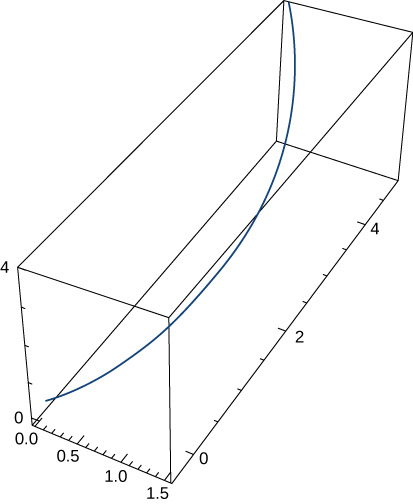
- Answer
- \(a_\mathbf{T}=\sqrt{3}e^t, \quad a_\mathbf{N}=\sqrt{2}e^t\)
- \(\mathbf r(t)=⟨\frac{2}{3}(1+t)^{3/2}, \,\frac{2}{3}(1-t)^{3/2},\,\sqrt{2}t⟩\)
- \(\mathbf r(t)=\left\langle 2t,\,t^2,\,\dfrac{t^3}{3}\right\rangle\)
- Answer
- \(a_\mathbf{T}=2t, \quad a_\mathbf{N}=2\)
- \(\mathbf r(t)=t^2\,\mathbf{i}+t^2\,\mathbf{j}+t^3\,\mathbf{k}\)
- \(\mathbf r(t)=⟨6t,\,3t^2,\,2t^3⟩\)
- Answer
- \(a_\mathbf{T}=\dfrac{6t +12t^3}{\sqrt{1+t^2+t^4}}, \quad a_\mathbf{N}=6\sqrt{\dfrac{1+4t^2+t^4}{1+t^2+t^4}}\)
- \(\mathbf r(t)=3\cos(2πt)\,\mathbf{i}+3\sin(2πt)\,\mathbf{j}\)
- Answer
- \(a_\mathbf{T}=0, \quad a_\mathbf{N}=12\pi^2\)
- \(\mathbf r(t)=a\cos(ωt)\,\mathbf{i}+b\sin(ωt)\,\mathbf{j}\) at \(t=0\).
Exercises 32 - 36
- Answer
- \(a_\mathbf{T}=0, \quad a_\mathbf{N}=aω^2\)
- Suppose that the position function for an object in three dimensions is given by the equation \(\mathbf r(t)=t\cos(t)\,\mathbf{i}+t\sin(t)\,\mathbf{j}+3t\,\mathbf{k}\).
- Show that the particle moves on a circular cone.
- Find the angle between the velocity and acceleration vectors when \(t=1.5\).
- Find the tangential and normal components of acceleration when \(t=1.5\).
- Answer
-
- \(a_\mathbf{T}=0.43\,\text{m/sec}^2, \quad a_\mathbf{N}=2.46\,\text{m/sec}^2\)
- The force on a particle is given by \(\mathbf f(t)=(\cos t)\,\mathbf{i}+(\sin t)\,\mathbf{j}\). The particle is located at point \((c,0)\) at \(t=0\). The initial velocity of the particle is given by \(\mathbf v(0)=v_0\,\mathbf{j}\). Find the path of the particle of mass \(m\). (Recall, \(\mathbf F=m\mathbf a\).)
- Answer
- \(\mathbf r(t)=\left(\dfrac{-\cos t}{m}+c+\frac{1}{m}\right)\,\mathbf{i}+\left(\dfrac{−\sin t}{m}+\left(v_0+\frac{1}{m}\right)t\right)\,\mathbf{j}\)
- An automobile that weighs \(2700\) lb makes a turn on a flat road while traveling at \(56\) ft/sec. If the radius of the turn is \(70\) ft, what is the required frictional force to keep the car from skidding?
- Using Kepler’s laws, it can be shown that \(v_0=\sqrt{\dfrac{2GM}{r_0}}\) is the minimum speed needed when \(\theta=0\) so that an object will escape from the pull of a central force resulting from mass \(M\). Use this result to find the minimum speed when \(\theta=0\) for a space capsule to escape from the gravitational pull of Earth if the probe is at an altitude of \(300\) km above Earth’s surface.
- Answer
- \(10.94\) km/sec
- Find the time in years it takes the dwarf planet Pluto to make one orbit about the Sun given that \(a=39.5\) A.U.
Contributors
Gilbert Strang (MIT) and Edwin “Jed” Herman (Harvey Mudd) with many contributing authors. This content by OpenStax is licensed with a CC-BY-SA-NC 4.0 license. Download for free at http://cnx.org.


